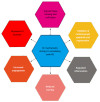Stem cell mechanisms during left ventricular remodeling post-myocardial infarction: Repair and regeneration
- PMID: 25068021
- PMCID: PMC4110609
- DOI: 10.4330/wjc.v6.i7.610
Stem cell mechanisms during left ventricular remodeling post-myocardial infarction: Repair and regeneration
Abstract
Post-myocardial infarction (MI), the left ventricle (LV) undergoes a series of events collectively referred to as remodeling. As a result, damaged myocardium is replaced with fibrotic tissue consequently leading to contractile dysfunction and ultimately heart failure. LV remodeling post-MI includes inflammatory, fibrotic, and neovascularization responses that involve regulated cell recruitment and function. Stem cells (SCs) have been transplanted post-MI for treatment of LV remodeling and shown to improve LV function by reduction in scar tissue formation in humans and animal models of MI. The promising results obtained from the application of SCs post-MI have sparked a massive effort to identify the optimal SC for regeneration of cardiomyocytes and the paradigm for clinical applications. Although SC transplantations are generally associated with new tissue formation, SCs also secrete cytokines, chemokines and growth factors that robustly regulate cell behavior in a paracrine fashion during the remodeling process. In this review, the different types of SCs used for cardiomyogenesis, markers of differentiation, paracrine factor secretion, and strategies for cell recruitment and delivery are addressed.
Keywords: Angiogenesis; Fibrosis; Inflammation; Left ventricular remodeling; Myocardial infarction; Review; Stem cell regeneration.
Figures


References
-
- Roger VL, Go AS, Lloyd-Jones DM, Benjamin EJ, Berry JD, Borden WB, Bravata DM, Dai S, Ford ES, Fox CS, et al. Executive summary: heart disease and stroke statistics--2012 update: a report from the American Heart Association. Circulation. 2012;125:188–197. - PubMed
-
- Alpert JS, Thygesen K, Antman E, Bassand JP. Myocardial infarction redefined--a consensus document of The Joint European Society of Cardiology/American College of Cardiology Committee for the redefinition of myocardial infarction. J Am Coll Cardiol. 2000;36:959–969. - PubMed
-
- Go AS, Mozaffarian D, Roger VL, Benjamin EJ, Berry JD, Borden WB, Bravata DM, Dai S, Ford ES, Fox CS, et al. Executive summary: heart disease and stroke statistics--2013 update: a report from the American Heart Association. Circulation. 2013;127:143–152. - PubMed
-
- Pocock SJ, Wang D, Pfeffer MA, Yusuf S, McMurray JJ, Swedberg KB, Ostergren J, Michelson EL, Pieper KS, Granger CB. Predictors of mortality and morbidity in patients with chronic heart failure. Eur Heart J. 2006;27:65–75. - PubMed
-
- Beltrami AP, Urbanek K, Kajstura J, Yan SM, Finato N, Bussani R, Nadal-Ginard B, Silvestri F, Leri A, Beltrami CA, et al. Evidence that human cardiac myocytes divide after myocardial infarction. N Engl J Med. 2001;344:1750–1757. - PubMed
Publication types
LinkOut - more resources
Full Text Sources
Other Literature Sources
Research Materials

